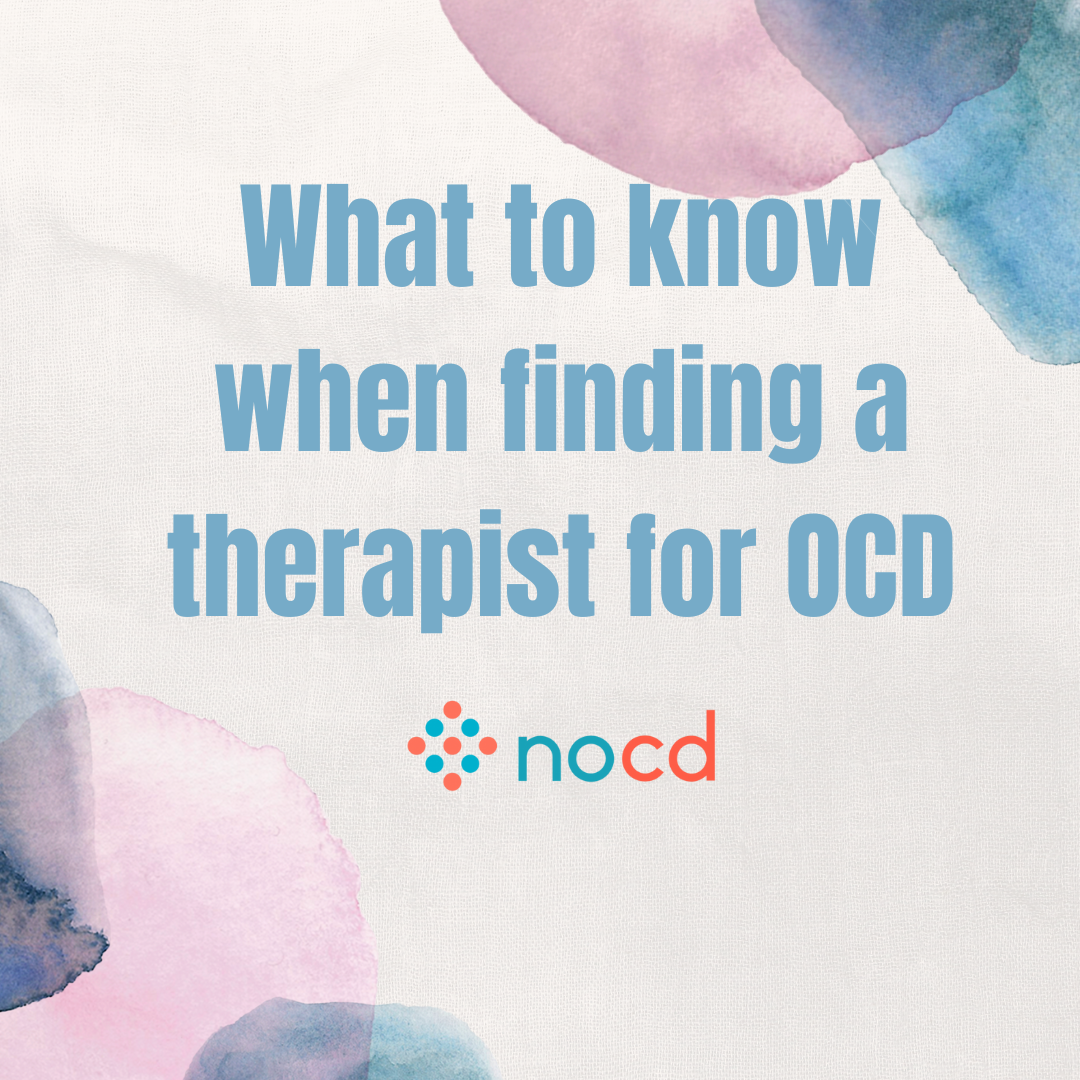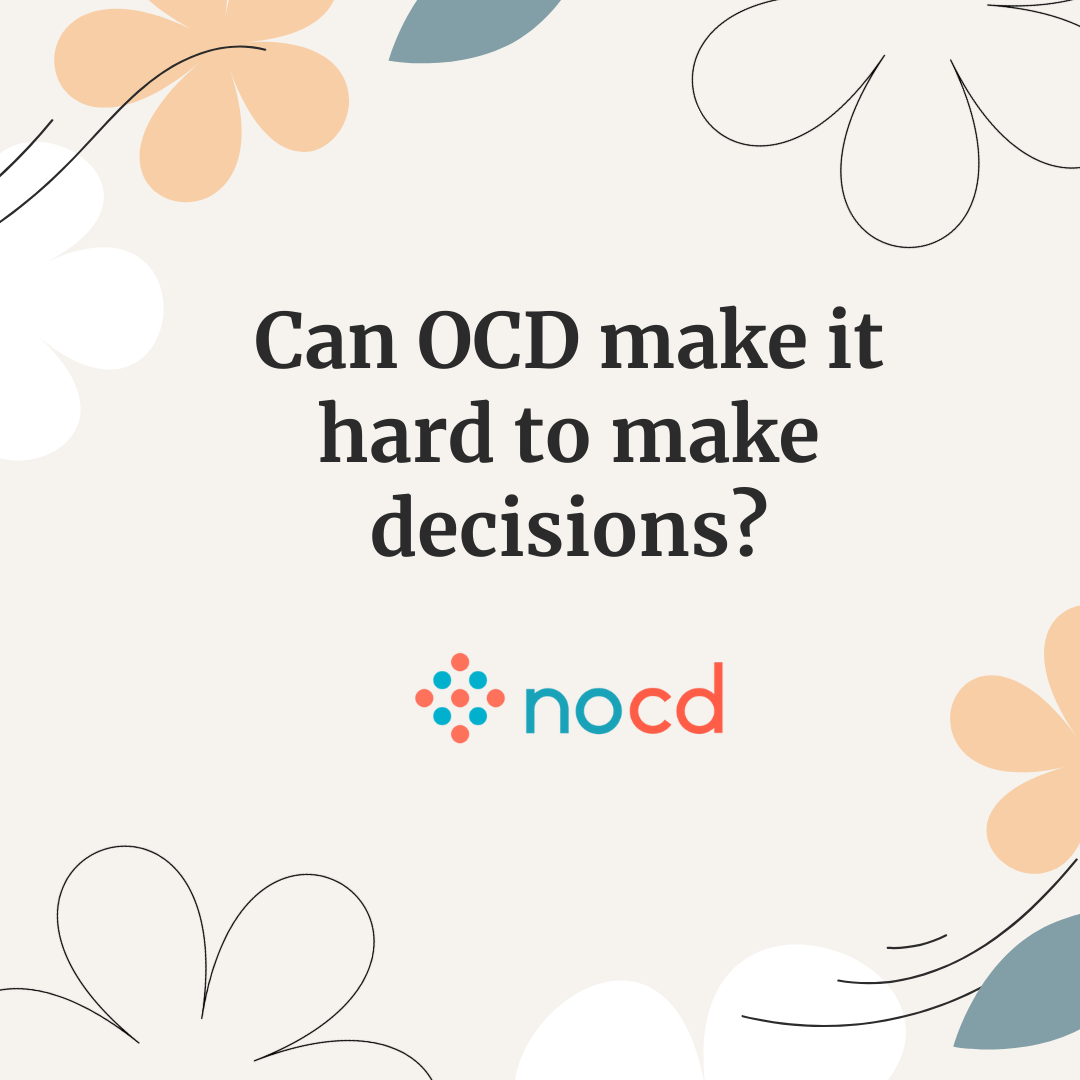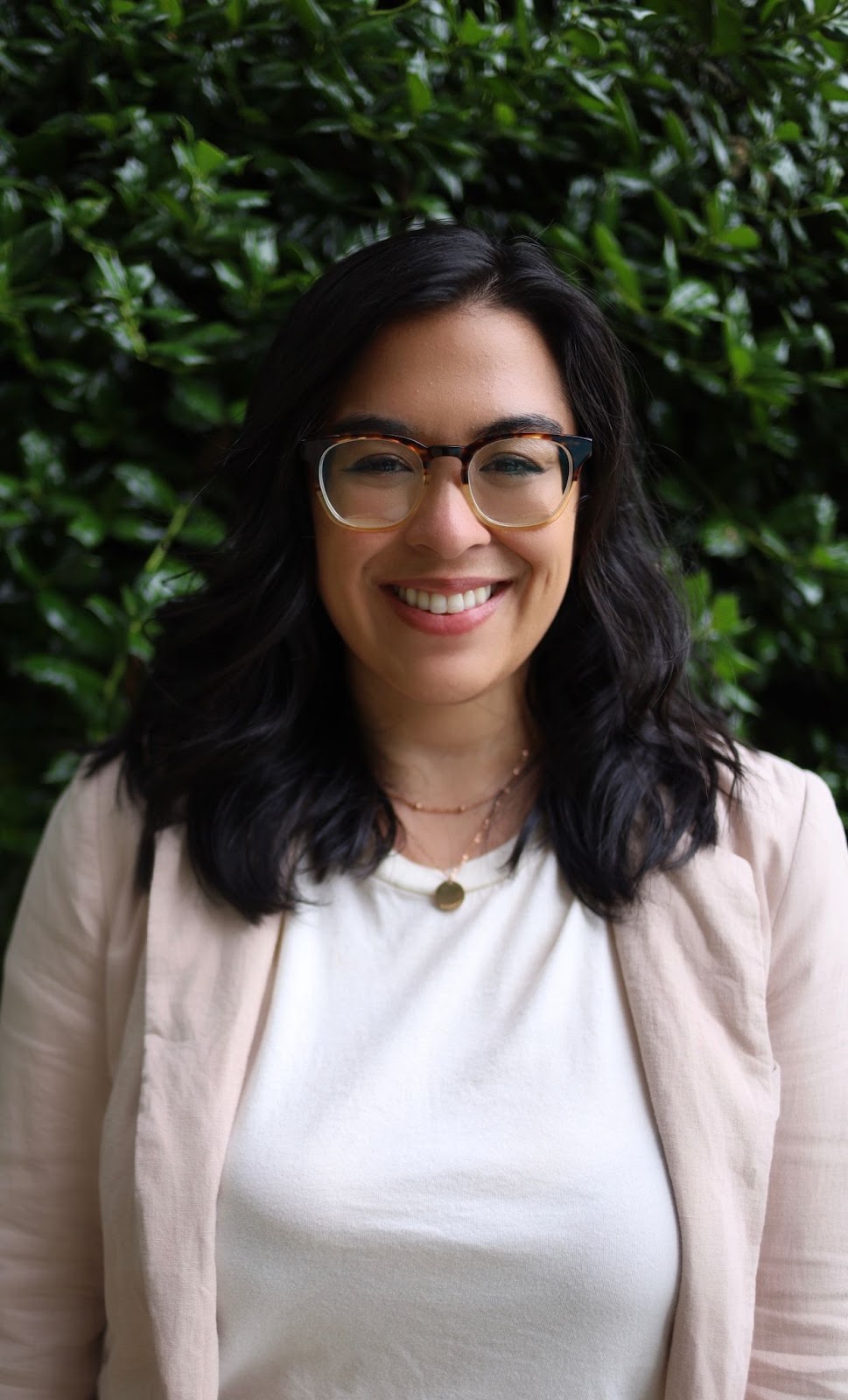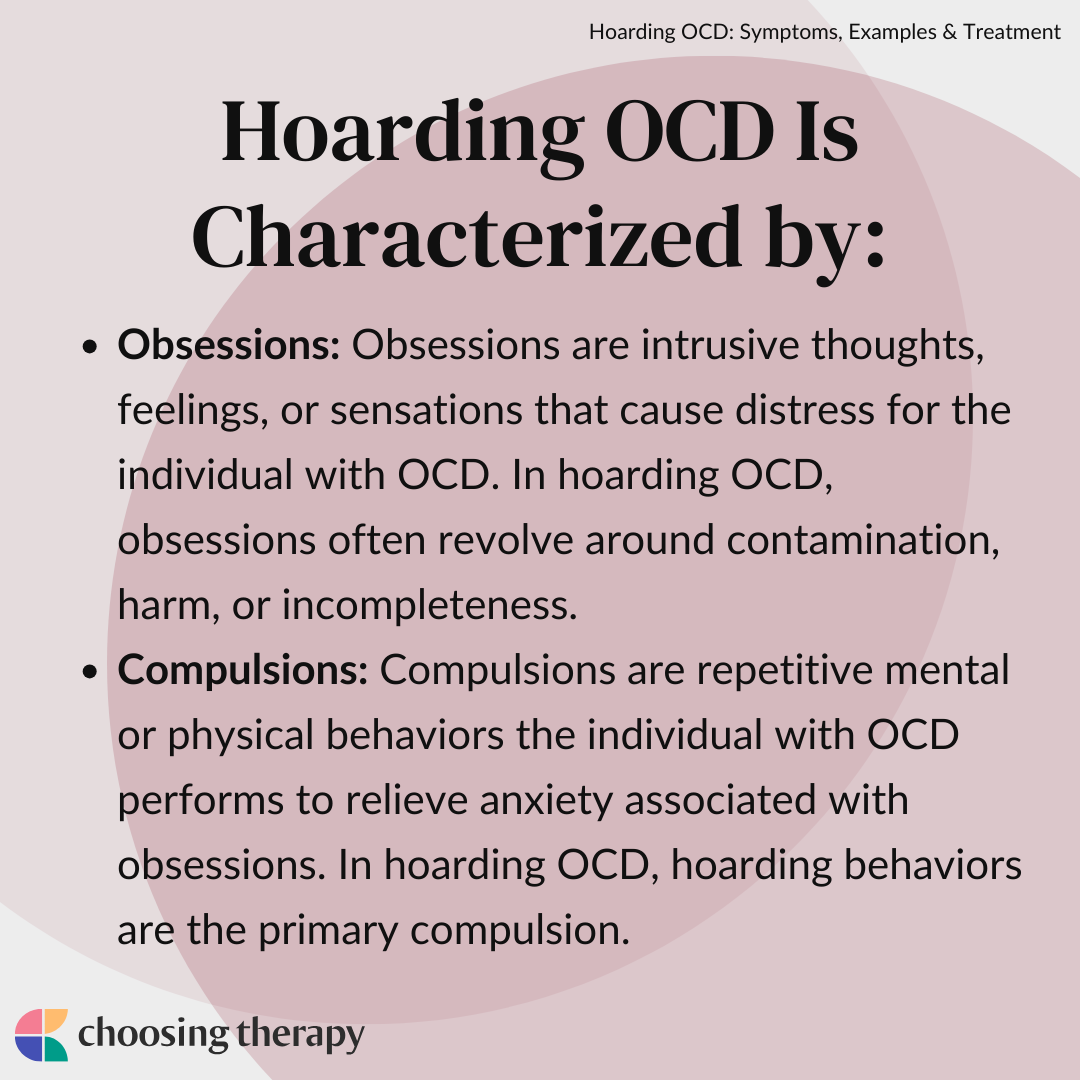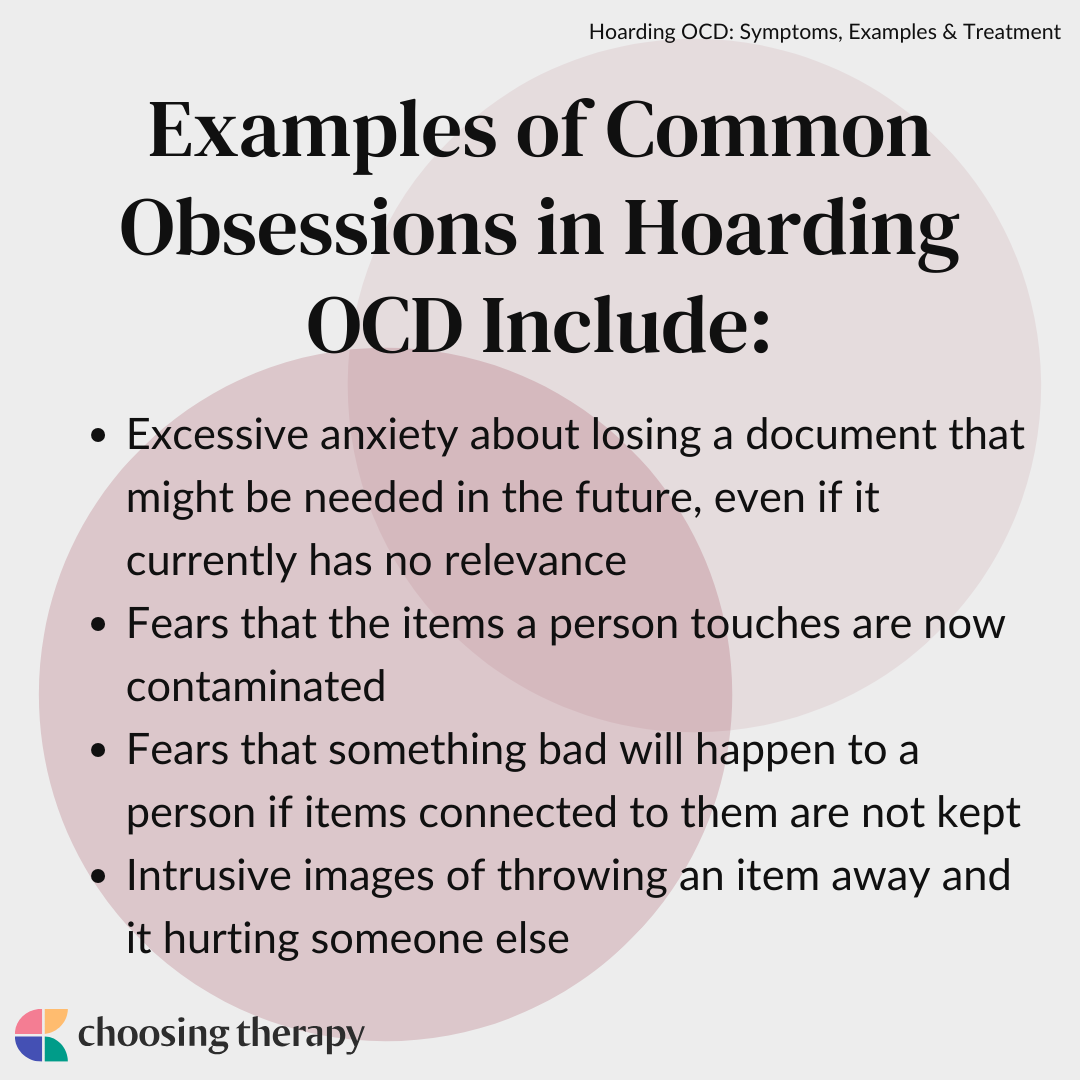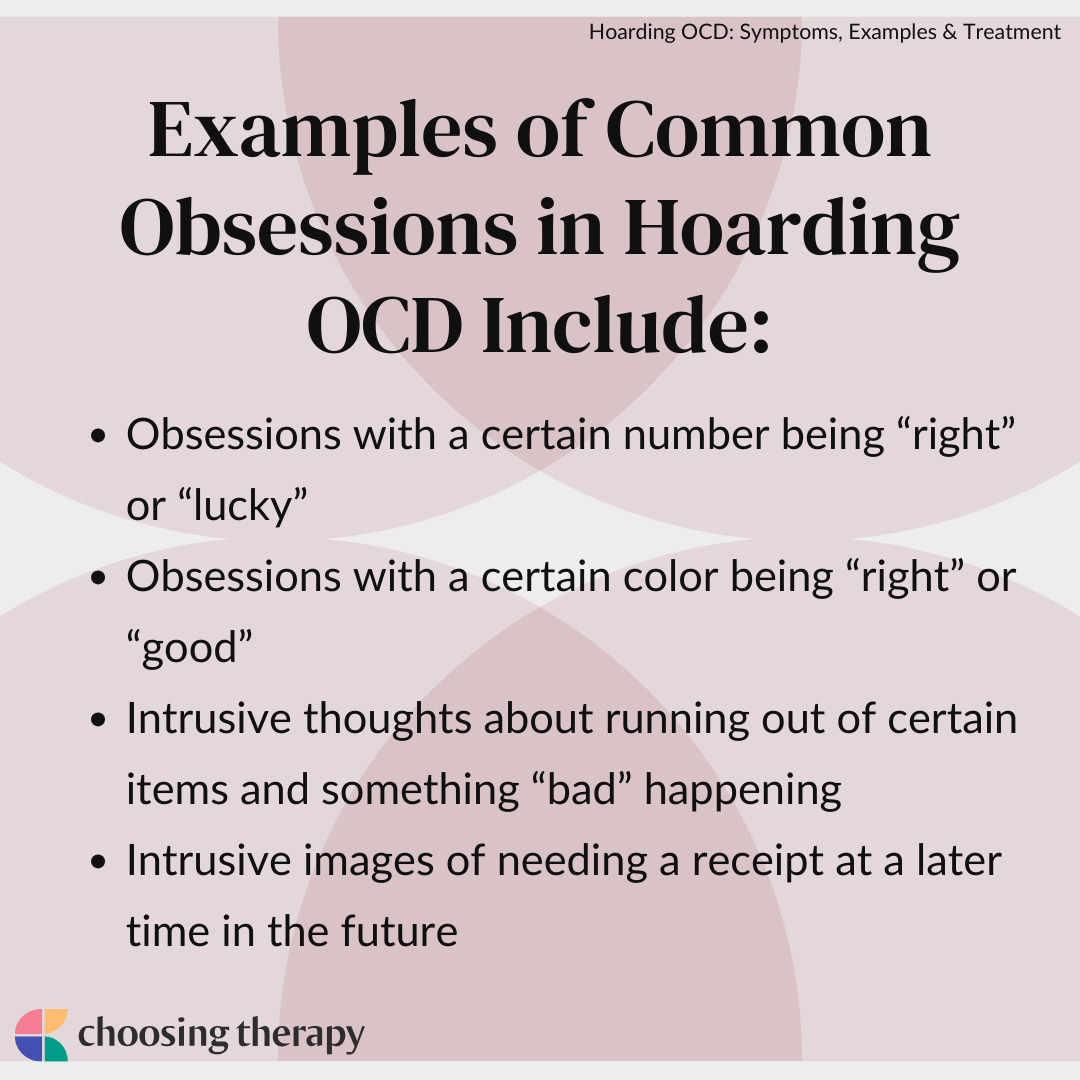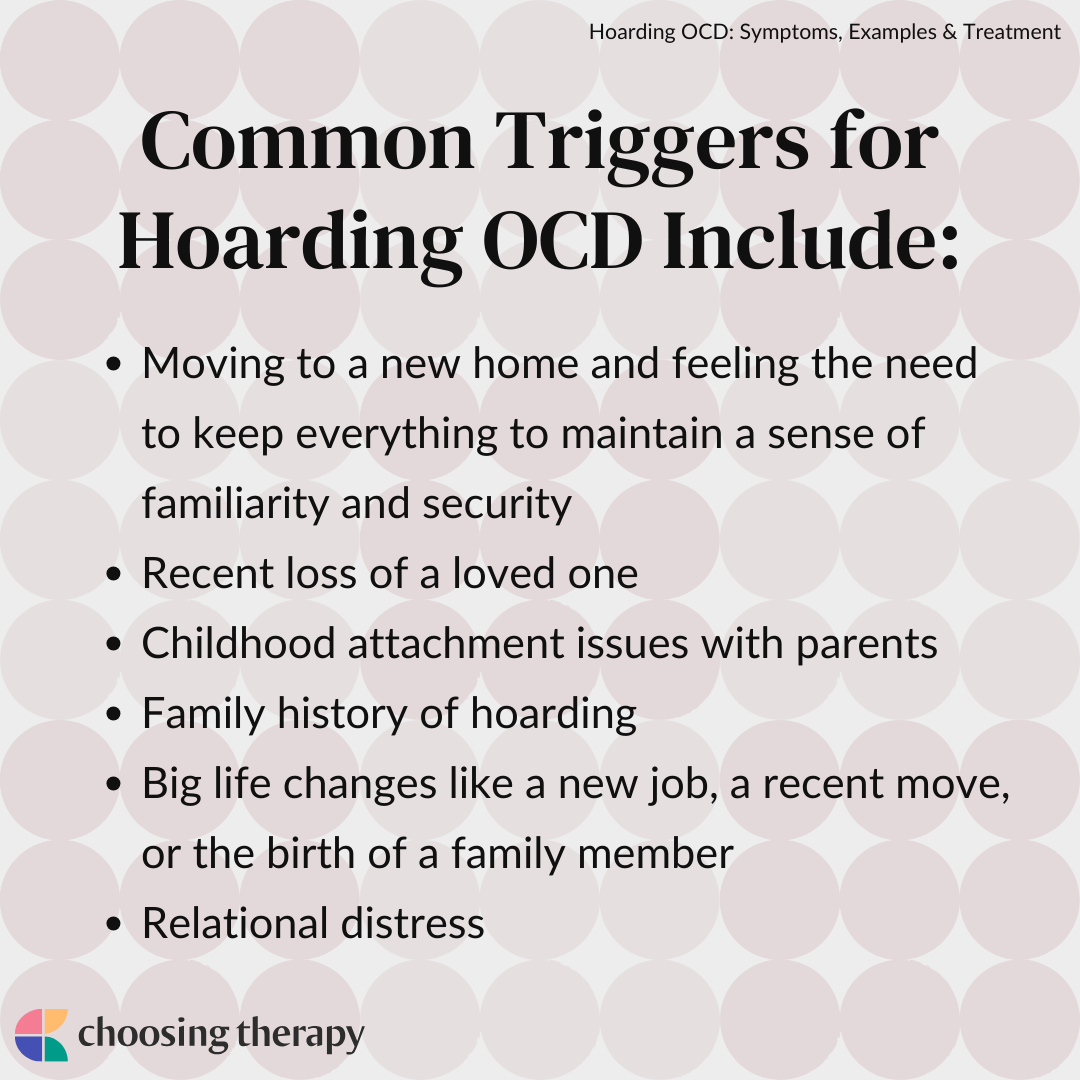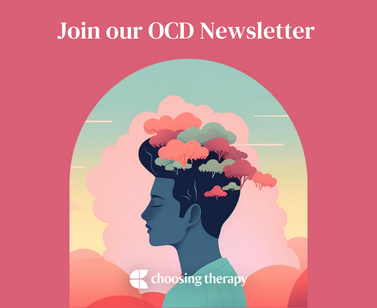Hoarding OCD is an OCD subtype where the person compulsively gathers unnecessary items because of obsessional thoughts, images, or urges.1 Hoarding OCD can be triggered by underlying genetics, parental upbringing, traumatic events, brain abnormalities, or stressful life changes.1, 2, 3 Treatment options include standard OCD therapies like ERP and CBT, in-home therapies, and medications like SSRIs and SNRIs.3
What is the best therapy for OCD? Exposure And Response Prevention Therapy (ERP) – Do live video sessions with a therapist specialized in ERP, the gold standard treatment for OCD. Treatment from NOCD is covered by many insurance plans. Start With A Free 15 Minute Call
What Is Hoarding OCD?
Hoarding OCD is a subtype of obsessive compulsive disorder (OCD) where a person exhibits hoarding behaviors directly related to an OCD obsession. In Hoarding OCD, a person experiences intrusive thoughts or obsessions and then compulsively gathers items in response to their distress. Hoarding OCD can impact a person’s living space, hygiene, ability to perform basic daily chores, and relationships with others.
The DSM-5 does not recognize specific subtypes of OCD. However, experts know that around 20% of individuals who exhibit hoarding behaviors are also diagnosed with OCD.1 Individuals who are indecisive are more likely to develop a hoarding disorder.1 Traumatic events are also connected with the beginning or exacerbation of hoarding behaviors.1 According to the DSM-5, hoarding behaviors are also highly hereditary, with 50% attributable to genetic factors.1
Hoarding OCD is characterized by:
- Obsessions: Obsessions are intrusive thoughts, feelings, or sensations that cause distress for the individual with OCD. In hoarding OCD, obsessions often revolve around contamination, harm, or incompleteness.
- Compulsions: Compulsions are repetitive mental or physical behaviors the individual with OCD performs to relieve anxiety associated with obsessions. In hoarding OCD, hoarding behaviors are the primary compulsion.
Is All Hoarding a Sign of OCD?
Not all hoarding behaviors are a sign of OCD. However, both Hoarding Disorder and OCD fall under the same diagnostic category in the DSM-5 because they can share some similarities, like difficulty discarding hoarded items. In hoarding disorder, the person has persistent difficulty parting with possessions, which leads to saving an excessive number of items. Excessive accumulation may or may not be present in Hoarding OCD.
According to the DSM-5, approximately 20% of individuals who have hoarding disorder also qualify for an OCD diagnosis.1 OCD is also diagnosed in individuals who have hoarding disorder when severe hoarding behaviors co-occur with separate obsessions and compulsions not related to hoarding. OCD is diagnosed instead of hoarding disorder when hoarding is a compulsion related to a specific obsession.
Hoarding Disorder Vs. Hoarding OCD
Hoarding Disorder is not diagnosed when symptoms are directly related to obsessions, such as fears of contamination, harm, or incompleteness.1 In OCD, compulsions are unwanted and distressing. In Hoarding OCD, individuals compulsively gather items but tend not to experience any pleasure from hoarding.1 Individuals with Hoarding OCD are also more likely to collect bizarre items, such as urine, trash, feces, nails, used diapers, rotten food, or hair.1
According to the DSM-5, 80-90% of individuals with hoarding disorder gather items to excessive levels.1 In Hoarding OCD, excessive acquisition is generally not present. When it is present, the items gathered are due to particular obsessions, such as buying items so they do not contaminate others. In Hoarding Disorder, the person buys because of a genuine desire to have the items.1
Symptoms of Hoarding OCD
Hoarding OCD presents with general features and symptoms of OCD, such as obsessions and compulsions. Hoarding OCD is different from other forms of OCD in that OCD hoarding behaviors are the general compulsion associated with the disorder. Obsessions typical of Hoarding OCD include contamination fears, feelings of incompleteness, and intrusive thoughts of harm to self and others.
Examples of common obsessions in hoarding OCD include:
- Excessive anxiety about losing a document that might be needed in the future, even if it currently has no relevance
- Fears that the items a person touches are now contaminated
- Fears that something bad will happen to a person if items connected to them are not kept
- Intrusive images of throwing an item away and it hurting someone else
- Obsessions with a certain number being “right” or “lucky”
- Obsessions with a certain color being “right” or “good”
- Intrusive thoughts about running out of certain items and something “bad” happening
- Intrusive images of needing a receipt at a later time in the future
Examples of common compulsions in hoarding OCD include:
- Accumulating an ever-growing emergency kit to prepare for all possible future catastrophes or emergencies
- Buying touched items in a store to prevent them from making others sick
- Keeping all greeting cards or correspondence from a friend or family member
- Keeping all breakables so that they do not break in the trash and injure others
- Buying items in multiples of “special” numbers
- Only buying items in certain colors that are considered “good”
- Buying a surplus or sets of items to prevent fears of running out
- Keeping all receipts, regardless of actually needing them for returns
How much do you know about OCD? Take This 11-Question OCD Quiz From NOCD. If you or a loved one are struggling with OCD, NOCD provides convenient, affordable, and effective OCD treatment covered by most major insurance plans.
What Triggers Hoarding OCD Symptoms?
Hoarding OCD symptoms can be triggered by stressful life events, similar to other common OCD triggers. Research also indicates a link between traumatic events and OCD hoarding behaviors, such as the recent loss of a loved one. Additionally, some research supports the idea that insecure attachment to parental figures can trigger hoarding behaviors as a form of attachment to objects.3
Common triggers for hoarding OCD include:
- Moving to a new home and feeling the need to keep everything to maintain a sense of familiarity and security
- Recent loss of a loved one
- Childhood attachment issues with parents
- Family history of hoarding
- Big life changes like a new job, a recent move, or the birth of a family member
- Relational distress
Causes of Hoarding OCD
Hoarding OCD is caused by a variety of environmental, biological, and genetic factors. Similar to other subtypes of OCD, OCD hoarding behaviors are highly heritable and also influenced by familial upbringing.1, 3 New research indicates that the neurobiology of individuals who exhibit OCD hoarding behaviors may be different from non-hoarding OCD individuals.6
Possible causes of hoarding OCD include:
- Genetics: Genetics linked with OCD can influence the onset of Hoarding OCD symptoms. Research indicates up to 50% of hoarding behaviors are attributable to genetic factors.1
- Environmental factors: Environment plays a large part in how hoarding OCD symptoms present. Family members can either challenge or enable hoarding behaviors, making them a possible cause of maintaining symptoms.
- Parental Behaviors: Research indicates that a lack of parental warmth can cause hoarding OCD behaviors.5
- Brain activity: Research indicates that individuals with hoarding OCD may metabolize glucose at slower rates in the region of the brain involved in decision-making, categorization, and implicit learning.6 These findings suggest that the neurobiology of individuals who exhibit hoarding behaviors in OCD may be distinct from non-hoarding OCD individuals.6
Impacts of Hoarding OCD
Hoarding OCD often impacts someone’s daily life and relationships. Clutter can contribute to the inability to carry out daily tasks like cooking, cleaning, and sleeping. One study found that people with hoarding OCD were less likely to be married than non-hoarding individuals.3 The same study also found that people with hoarding OCD often have lower socioeconomic status than non-hoarders.3
Individuals with Hoarding OCD are also likely to have co-occurring mental health conditions, specifically social anxiety disorder, bipolar disorder, and substance use issues.3 Research indicates that hoarding OCD is one of the more severe types of OCD, and shows an increase in overall global impairment compared to other subtypes.3
How Is Hoarding OCD Diagnosed?
A mental health professional can provide an OCD diagnosis. A medical doctor may need to rule out other medical disorders that can contribute to personality changes, such as brain injuries or cerebrovascular disease.1 For OCD to be diagnosed, there has to be obsessions and compulsions present, with hoarding being the primary compulsion in Hoarding OCD.1
Questions to ask your doctor about hoarding OCD include:
- Where can I find specialized hoarding OCD treatment?
- What does a typical treatment plan look like?
- Do I have other compulsions that may complicate treatment?
- What does the prognosis look like for my remission from symptoms?
- How can I involve my support system in treatment?
Treatment for Hoarding OCD
Treatment for Hoarding OCD is based on standardized OCD treatment. A comprehensive treatment plan includes medication, therapy, and in-home support if needed. Since hoarding behavior occurs in the home, sometimes specialized mental health professionals will conduct home visits or offer in-home support as needed. A medical doctor may also be involved to rule out medical conditions, such as brain injuries, that can cause hoarding behaviors.1
Treatment For OCD NOCD: Online OCD Treatment Covered By Insurance – Regain your life from OCD. Do live video sessions with a licensed therapist specialized in treating OCD. Treatment from NOCD is covered by most major insurance plans. Learn how you can use your insurance benefits. Visit NOCD Talkiatry: Is OCD Medication Right For You? Speak with A Doctor – Talkiatry can match you with a psychiatrist who takes your insurance and is accepting new patients. They’re in-network with major insurers and offer medication management with supportive therapy. Free Assessment
Therapy for Hoarding OCD
Therapy approaches for Hoarding OCD are based on standard therapy approaches for OCD. Therefore, the gold standard treatment for Hoarding OCD is Exposure Response Prevention. When ERP is contraindicated, CBT may be recommended to target maladaptive intrusive thought processes. Motivational interviewing approaches may be used to address any ambivalence about starting the therapy process. In severe cases, therapy may be conducted at home.
Effective therapy options for OCD include:3
- Exposure response prevention (ERP): Exposure response prevention exposes the individual to feared situations, while preventing the use of compulsions. For Hoarding OCD, hoarding behaviors would be slowly confronted and prevented so that the individual could learn to tolerate obsessions without using compulsive hoarding.
- Cognitive behavioral therapy (CBT): CBT for OCD helps the individual learn to understand how maladaptive intrusive thoughts lead to the distress associated with OCD obsessions. Through CBT, someone with hoarding OCD would learn how their intrusive thoughts are connected to their hoarding behaviors, and learn new adaptive behaviors to cope.
- Motivational Interviewing: Motivational interviewing aims to address ambivalence around change. MI can help someone with hoarding OCD figure out whether they want to pursue treatment, and what they are willing to change about hoarding symptoms.
- At-Home Therapy: Therapy may be conducted at-home, or at the very least a clinician may assess in-home to see how hoarding symptoms are affecting someone’s quality of life. Since therapy may involve sorting through and discarding items, exposures can be helpful when approached in person.
Medication for Hoarding OCD
Medications for managing Hoarding OCD are based on medications for managing OCD in general. Commonly prescribed medications include SSRIs and SNRIs, which regulate available serotonin levels.3 Having a tailored treatment plan which incorporates medication, therapy, and any at-home therapy sessions is important to develop at the beginning of starting treatment for hoarding OCD.
How to Cope With Hoarding OCD
Coping skills for OCD include developing basic self-care and routines and approaching hoarding behaviors with mindfulness. Developing an exposure hierarchy with the help of a professional can help you plan exposures, while having a home organization system can offer you structure as you begin to discard items. If needed, an in-home therapist can offer more direct support during exposures.
What is the best therapy for OCD? Exposure And Response Prevention Therapy (ERP) – Do live video sessions with a therapist specialized in ERP, the gold standard treatment for OCD. Treatment from NOCD is covered by many insurance plans. Start With A Free 15 Minute Call
Here are 8 number tips for coping with hoarding OCD:
1. Focus on Self-Care & Routine
Hoarding OCD can affect someone’s quality of life, which is why addressing self-care and routines is important at the beginning of treatment. Self-care routines may address basic needs, such as exercise, a balanced diet, and sufficient sleep. As therapy continues, exposures may address cleaning areas of the home that are obstacles to self-care behaviors. For example, removing hoarded items from atop the bed so that the person can sleep or discarding excessive kitchen clutter so that it is possible to prepare meals at home.
2. Limit Reassurance-Seeking Behaviors
OCD reassurance-seeking behaviors are common compulsions used by individuals with Hoarding OCD. Unfortunately, seeking reassurance only maintains the cycle of OCD obsessions and compulsions. You might start limiting reassurance-seeking behaviors by identifying the ways in which you ask for reassurance. You might also request from your loved ones that they deny giving you reassurance, and instead encourage you to practice distress tolerance when you feel compelled to hoard.
3. Practice Mindfulness
Mindfulness for Hoarding OCD can help bring awareness to the present moment, allowing you to acknowledge the obsession without engaging in compulsive hoarding. Mindfulness also allows you to develop patience and objectivity around obsessions. One strategy is to use meditation techniques for OCD, such as practicing loving-kindness meditations when finding yourself feeling impatient with failed exposures around OCD hoarding behaviors.
Additionally, you can practice having a more mindful attitude when acquiring new possessions. Become more mindful about what obsessions are connected to your urge to use hoarding behaviors.
Questions to ask yourself before acquiring new possessions:
- Why do I feel I need this item?
- Is this item connected to one of my obsessional themes?
- How hard would it be for me to walk away from this item?
- If I chose to walk away, what strategy can I use to cope?
4. Utilize Online Resources & Technology
Online OCD resources can provide support and information about Hoarding OCD. Blogs like Beyond OCD can help expose you to stories of other individuals who struggle with hoarding symptoms. The OCD Stories Podcast contains relevant and accurate information about subtypes of OCD, such as hoarding. Other resources, like NOCD, offer therapy, support, and informational articles on Hoarding OCD.
5. Urge Surf
You can learn to surf the urges of compulsive OCD hoarding without engaging in behaviors. Urge surfing can help you prevent compulsive hoarding as it re-focuses your attention to acknowledging urges in an objective manner. Through developing a nonjudgmental and objective attitude, you become more at peace with experiencing urges and not engaging in hoarding.
6. Develop an Exposure Hierarchy for Hoarding
It is likely with hoarding OCD that you have some OCD hoarding behaviors that feel more manageable than others. A mental health professional can help you develop a hierarchy for addressing hoarding behaviors, beginning with the one that causes the least amount of distress. As you practice smaller exposures, you will likely gain the confidence to tackle larger ones.
7. Develop a Home Organization System
Sometimes people with OCD hoarding might struggle with organization, and other times they may not. For those that do find it hard to organize the items they accumulate, developing a system for organizing can help. As you begin treatment, you may begin to practice discarding unneeded items. Having an organizing system in place can help you decide which items are helpful to keep.
8. Consider an In-home Therapist
Since Hoarding OCD directly involves someone’s living space, an in-home therapist can address exposures where they matter the most. The benefit of in-home therapy is that a therapist can conduct an in-depth assessment of symptoms, especially if they are pretty severe. Additionally, in-home therapy offers the therapist the ability to coach through exposures as you complete them.
When to Seek Professional Support
If hoarding OCD is impacting daily living abilities such as eating, sleeping, or cooking, it may be time to seek professional support. Especially if symptoms are impacting the ability to keep up with personal hygiene and causing relational distress, it may be time to use an online therapist directory or online therapy platform. Medication management can be offered through online psychiatrist options.
In My Experience
To help our readers take the next step in their mental health journey, Choosing Therapy has partnered with leaders in mental health and wellness. Choosing Therapy is compensated for marketing by the companies included below. OCD Therapy NOCD: Effective, Affordable, & Convenient OCD Therapy Do live, face-to-face video sessions with a therapist who specializes in treating OCD and get 24/7 support between sessions. NOCD is covered by many insurance plans and is available nationwide. Visit NOCD Treatment From An Online Psychiatrist Talkiatry OCD is treatable. Talkiatry specializes in OCD and provides personalized care with medication and additional support. Get started with a short assessment. OCD Newsletter A free newsletter from Choosing Therapy for those impacted by OCD. Get helpful tips and the latest information. Sign-UpAdditional Resources
What to know when finding a therapist for OCD With so much information out there regarding providers and treatment options for obsessive compulsive disorder, it can be hard to know exactly where to start—especially when you have to consider everything from the type of provider to the different treatment methods, as well as how you’ll fit it into your busy schedule. Can OCD make it hard to make decisions? From choosing what to wear in the morning to picking what to eat for dinner, decision-making is a part of everyone’s daily routine. But for millions of people with Obsessive-Compulsive Disorder (OCD), making any choice can feel like a daunting, sometimes impossible task.